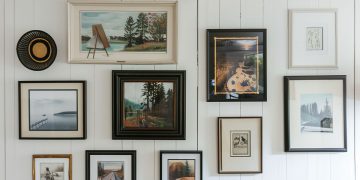
Free Image via Unsplash
Biophilic interior design. If you’re interested in home improvements and décor, you’ve likely heard that term in the last few years. But what is biophilic design – and how can you best incorporate the trend into your home or workspace? Never fear, the Storage Queens are here to explain and inspire.
Biophilia is defined by Merriam Webster as the “human tendency to interact or be closely associated with other forms of life in nature.” When it comes to your living space, however, biophilia is best represented as natural interior design. Think plants (lots and lots of plants), in addition to natural shapes, materials and colors. Taken together, all of this nature-inspired décor serves to calm the nervous system, increase productivity, and make your home, office or anywhere else you incorporate it a pleasant and serene place to be.
If you’re just dipping your toes into the topic, we suggest you start with our recent piece, 6 Ways to Embrace a Biophilic Home and Step Into Nature Anytime for a primer explaining how to incorporate biophilic design without too much time, effort, or cash.
For those of you who already know the basics of biophilic interior design, keep scrolling to take a look at how the trend has evolved and what the hottest elements are in 2023. As Kermit the Frog famously said, “It ain’t easy being green.” Hopefully, our tips and advice will show you the opposite – at least when it comes to biophilic design interiors!
Nature-Inspired Interior Design Takes Center Stage

Free Image via Unsplash
Nature-inspired interior design has been having a moment (or a series of moments) since the advent of COVID-19 in 2020. Over the last few years, those of us stuck in our homes for weeks or months at a time began to value the harmony and beauty of nature in a whole new way. While the concept itself was first written about in 1984 by a biologist named E.O. Wilson, we are still just beginning to understand the benefits of biophilic design and the impact it can have on our brains and bodies.
Today, the demand for interior biophilic design and nature-inspired décor has never been stronger. The design movement itself has evolved from its beginning (think a few houseplants scattered here and there and maybe a botanical print or two) to incorporate natural elements into every aspect of our home and work lives. The scale has changed as well. Where once, we might have been happy with just a smattering of natural (or even “nature-inspired”) elements, today’s biophilic homes and offices show their intentions with big, bold statements.
Below, we’ll cover three ideas to incorporate biophilic design elements destined to make a big splash – and perhaps even have a big impact on your health and well-being. While these ideas may be more aspirational than practical, they’ll give you an idea of what is on trend today and maybe even a glimpse into where the look will go in the future. At least we know one thing for certain: biophilic interior design is here to stay.
Biophilia Writ Large: Living Walls

Free Image via Unsplash
While individual houseplants are – and will likely always remain – core biophilic design elements, true adherents to the trend are taking that idea several steps further and installing living walls in their interiors. Living walls? If you haven’t seen one in person, imagine an incredibly dense, lush, and compacted garden bed turned on its side.
Of course, vertical, hanging gardens have been a mainstay of folks trying to grow flowers or vegetables in cramped outdoor spaces for years. Living walls, on the other hand, are more focused on amplifying the impacts of biophilic design interiors. Lasting anywhere from 4 to 6 years with proper maintenance, these stunning pieces not only awe and impress – but often add mental health benefits as well. Interacting regularly with plants is thought to reduce cortisol levels, stress, and anxiety.
If you’re interested in adding a living wall to your home or workspace, there are a number of companies that sell kits for self-installation. For those of us whose green thumbs are more…brown and wilted, there are also horticultural experts who will come install the walls (or any other natural interior design pieces) for you.
Mirror, Mirror: Multiply the Effects of Your Nature-Inspired Décor

Free Image via Unsplash
Another trend in biophilic interior design is using mirrors to multiply the effects of your nature-inspired décor efforts. The mirrors themselves can (and perhaps should) also be biophilic, with curvilinear shapes and naturally colored wooden frames.
Not only will mirrors artfully reflect the flowers and greenery within your home, they also serve to dramatically increase the positive effects of natural light. If you’re low on windows, try tilting your mirrors to reflect the sunlight around the room. This will help make the room look brighter and bigger. Other ideas include:
- Placing mirrors on walls directly across from windows
- Incorporating mirrored furniture, accessories, and other décor elements around the house
- Adding small, framed mirrors on mantels or among a collection of framed photographs
Of course, you’ll need to make sure your light sources are ready for reflection. Remove any heavy drapes or any furniture blocking them to get the best effect. Keep in mind, however, that sunlight that comes into your house through glass doesn’t provide the same health positive attributes (i.e., Vitamin D) as direct sun exposure. Window glass absorbs UVB radiation, so – tempting as it might be – don’t rely on your newly brightened living space to give you the same exact benefits as being outdoors.
Reduce, Reuse, Recycle: Brighten Up Your Environment in a Low-impact Way

Free Image via Unsplash
Another big trend of 2023 is to incorporate biophilic interior design into all aspects of your living and working spaces in ways that reduce the impact of your activities on Mother Nature itself. What do we mean? We mean being on the lookout for any ways you can revamp existing décor elements for a more biophilic feel, rather than rushing out and buying new. Perhaps you’ve got a few rattan baskets in your CubeSmart storage unit that can be upcycled into lighting fixtures. Or old ceramic containers and glass jars lying around that can be transformed into planters.
Even outdated cotton t-shirts can be ripped up and turned into a rag rug. Biophilic interior design options are truly only limited by your imagination, willingness to put in the work, and what you either have on hand or can find in a secondhand store.
Another way to “recycle” plants is to propagate them. Propagating means taking a part of one “parent” plant and using it to create a number of “child” plants. There are a number of online articles and communities that provide great examples and inspiration for the process, which is fairly straightforward and extremely rewarding. Not to mention, it will make all (or most) of your interior biophilic design dreams come true at an extremely low price point!
It’s quite clear that nature-inspired interior design is here – and it’s here to stay. For more information, check out these resources:
20 Nature-Loving Homes Where Biophilia Thrives – Dwell
What is Biophilic Design and How to Incorporate It into Your Home – Barbulianno Design







